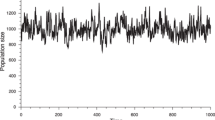Abstract
If censuses are taken at less than generation intervals, the number of successive censuses in which a given individual is recorded will depend on longevity. Repeatedly recording the same individuals could produce under-estimates of population variability and influence detection of density dependence. We investigated this possibility in 60 time series of abundances of British birds compiled from the Common Birds Census data and then used simple population models to illustrate the proposed mechanism. Species had average lifespans of 2–10 years and were censused annually. Density dependence was detected (at P<0.05) much more frequently in bird species with long lifespans than in those with short lifespans; 75% of the 12 longest-lived species showed density dependence compared to 46% of all species. Population variability measured in annual censuses (termed “annual variability”) was lower in bird species with longer lifespans. We used discrete time models based on difference equations to demonstrate how longevity influences population variability and detection of density dependence in series of annual censuses. A model in which only first-year birds experienced density dependence was rejected because annual variability was greater and detection of density dependence was less likely when longevity was greater, the opposite of the observed effects of longevity in birds. A model in which all age classes experienced density dependence gave time series with lower annual variability and in which density dependence was detected more frequently when longevity was greater, which is the pattern observed in British birds. Analysis of data from this model showed that the amount of density dependence actually present caused only small changes in annual variability, whereas detection of density dependence from simulated series was strongly influenced by annual variability. The high annual variability of series from short-lived bird species could mask any density dependence that was present. Correcting for trends lead us to detect density dependence in 75% of the 12 longest lived bird species. There is no reason to believe that this rate is not also representative of short-lived species.
Similar content being viewed by others
References
Baillie SR (1990) Integrated population monitoring of breeding birds in Britain and Ireland. Ibis 132: 151–166
Baillie SR, McCulloch N (1993) Modelling the survival rates of passerines ringed during the breeding season from national ringing recovery data. In: Lebreton J-D, North PM (eds) Marked individuals in the study of bird populations. Birkhäuser, Basel, pp 123–139
Bailey RS (1967) An index of bird population changes in farmland. Bird Study 14: 195–209
Brownie C, Anderson DR, Burnham KP, Robinson DS (1978) Statistical inference from band recovery data—a handbook. US Department of the Interior, Fish and Wildlife Service (Resource Publication no. 131) Washington
Bulmer MG (1975) The statistical analysis of density dependence. Biometrika 31: 901–911
Connell JH, Sousa WP (1983) On the evidence needed to judge ecological stability or persistence. Am Nat 121: 789–824
Cook LM (1965) Oscillations in the simple logistic growth model. Nature 207: 316
Crowley PH, Johnson DM (1992) Variability and stability of a dragonfly assemblage. Oecologia 90: 260–269
Dobson A (1990) Survival rates and their relationship to life-history traits in some common British birds. In: Power DM (ed) Current ornithology. Plenum, New York, pp 115–146
Hanski I, Woiwod IP (1993) Mean-related stochasticity and population variability. Oikos 67: 29–39
Holyoak M (1994) Appropriate time scales for identifying lags in density-dependent processes. J Anim Ecol 63: 479–483
Holyoak M, Baillie SR (1996) Factors influencing detection of density dependence in British birds: I. Population trends. Oecologia
Lack D (1943a) The age of the blackbird. Br Birds 36: 161–175
Lack D (1943b) The age of some British birds. Br Birds 36: 193–197
Link WA, Nichols JD (1994) On the importanc of sampling variance to investigations of temporal variation in animal population size. Oikos 69: 539–544
McArdle BH, Gaston KJ (1992) Comparing population variabilities. Oikos 64: 610–612
McArdle BH, Gaston KJ (1993) The temporal variability of populations. Oikos 67: 187–191
McArdle BH, Gaston KJ, Lawton JH (1990) Variation in the size of animal populations: patterns problems and artefacts. J Anim Ecol 59: 439–454
Pollard E (1977) A method for assessing changes in the abundance of butterflies. Biol Conserv 12: 115–134
Pollard E, Lakhani KH, Rothery P (1987) The detection of density dependence from a series of annual censuses. Ecology 68: 2046–2055
Reddingius J, Boer PJ den (1989) On the stabilization of animal numbers. Problems of testing. 1. Power estimates and estimation of errors. Oecologia 78: 1–8
Ricker WE (1954) Stock and recruitment. J Fish Res Bd Can 11: 559–623
Schoener TW (1985) Are lizard populations unusually constant through time? Am Nat 126: 633–641
Sinclair ARE (1989) Population regulation in animals. In: Cherrett JM, Bradshaw AD, Goldsmith FB, Grubb PJ, Krebs JR (eds) Ecological concepts: the contribution of ecology to an understanding of the natural world. Blackwell, Oxford, pp 197–241
Taylor LR (1961) Aggregation, variance and the mean. Nature 189: 732–735
Taylor SM (1965) The Common Birds Census — some statistical aspects. Bird Study 12: 268–286
Vickery WL, Nudds TD (1984) Detection of density dependent effects in annual duck censuses. Ecology 65: 96–104
Woiwod IP, Hanski I (1992) Patterns of density dependence in moths and aphids. J Anim Ecol 61: 619–630
Author information
Authors and Affiliations
Rights and permissions
About this article
Cite this article
Holyoak, M., Baillie, S.R. Factors influencing detection of density dependence in British birds. Oecologia 108, 54–63 (1996). https://doi.org/10.1007/BF00333214
Received:
Accepted:
Issue Date:
DOI: https://doi.org/10.1007/BF00333214




